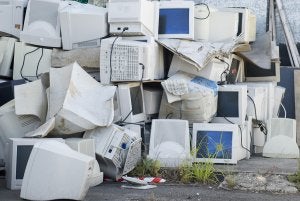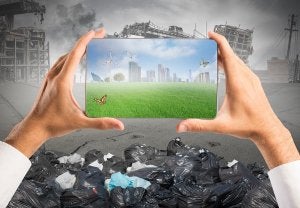-
How to Separate Materials
Large construction and demolition projects typically result in a great deal of scraps and waste in Atlanta at the conclusion of the task. Fortunately, this presents the opportunity for cardboard, plastic, and metal recycling, which can put these materials back into circulation rather than sending them to a landfill. Watch this video to find out how to separate these materials.
Separating out reusable materials from waste and debris is an important process, and it tends to be most successful when it is done on site because the materials are cleaner. Separating and recycling cardboard, plastic, and metal are typically easier tasks with construction projects, as demolition debris is sometimes contaminated. Qualified waste specialists can go through the waste products left over at the end of a project and sort out any useable lumber, aluminum, concrete, or other valuable materials that can be repurposed for new products, packaging, or projects.
-
How to Dispose of Electronic Waste
Your commercial or industrial business may see all different kinds of garbage, and hopefully you have an efficient system of recycling in Atlanta. Keep reading if you are interested in learning about how to dispose of electronic waste.
While recycling anything that can be recycled is a positive step for the environment, electronics tend to be very
 reusable. Old computers, printers, and cell phones often contain a substantial amount of materials that can be reused or repurposed for other applications. In addition to keeping these kinds of resources out of landfills, properly disposing of an electronic helps to ensure that fewer materials must be collected and used to manufacture new units, helping to conserve resources and minimize pollution. Larger, bulky appliances like desktop computers and televisions as well as smaller, mobile devices such as tablets and cell phones may all be recycled efficiently. The manufacturers of these devices typically offer specific recycling opportunities where you can dispose of your electronic waste, and retailers tend to provide opportunities as well. Look online for your next opportunity to donate or recycle your electronic waste.
reusable. Old computers, printers, and cell phones often contain a substantial amount of materials that can be reused or repurposed for other applications. In addition to keeping these kinds of resources out of landfills, properly disposing of an electronic helps to ensure that fewer materials must be collected and used to manufacture new units, helping to conserve resources and minimize pollution. Larger, bulky appliances like desktop computers and televisions as well as smaller, mobile devices such as tablets and cell phones may all be recycled efficiently. The manufacturers of these devices typically offer specific recycling opportunities where you can dispose of your electronic waste, and retailers tend to provide opportunities as well. Look online for your next opportunity to donate or recycle your electronic waste. -
Components of the Truck
A dump truck is similar to other large, industrial vehicles in many ways, but it also features a few unique components of its own; while they may not all look exactly the same, dump trucks tend to share these specific components. Much like a flatbed truck, a dump truck features one axle underneath the cab and one, two, or three axles underneath the dump box, depending on the truck itself. A dump truck utilizes an internal combustion engine that is either powered by gasoline or diesel fuel, and the dump box is powered by hydraulics and features a tailgate that usually opens automatically during the dumping process.
Hydraulic Dumping

A dump truck can relinquish its load in one of two ways: lifting or pushing. Although it requires more vertical clearance, lifting is the more popular method of dumping. In this case, the end of the dump box that is closest to the cab of the truck will be lifted using hydraulic pistons, which creates an angle and allows the contents of the dump truck to fall out. Dump trucks that use the pushing mechanism, on the other hand, rely on a vertical panel inside the dump box to push the contents of the box out through the tailgate.Dump Truck Power
While the dump truck itself is powered in the same way as other gas or diesel trucks, the truck and the dumping mechanism both rely on the internal combustion engine. The transmission connects to the power take off, which powers the hydraulics; if the truck is off, the dumping mechanism cannot be used. -
Reuse, Reduce, Recycle: Establishing an “R3” Program
Increasingly, our clients and prospective clients are interested in sustainability and operating in a way that is supportive of the environment as well as the communities in which they operate for the long term. With increasing focus from both the public and private sector as well as pressure from end-user consumers to be “more green,” forward-thinking organizations of all shapes and sizes are looking not only for mechanisms to help them be more environmentally sensitive but to follow a model for sustainability that affords them livelihood
 into the next century. Southern Waste & Recycling clients are interested
into the next century. Southern Waste & Recycling clients are interested
in how their policies and operations affect:· The environment
· Financial performance
· People, locally and globally
Organizations that embrace sustainability find that their efforts yield stronger financial performance and profitability, improved investment from stakeholders and enhanced employee commitment. They also enjoy an improved reputation and increased brand awareness for their products and services because of their sustainability initiatives.
The concept of sustainability is easy to grasp at a high level. But as you get into the nuts and bolts and put theory into practice, this concept becomes more complex. What is the impact on a business’ strategy and day-to-day operations? How will the organization’s stakeholders be affected? How can you measure the impact of your operations, products and services on the environment? How can you improve on a continual basis?
While the specific metrics in what is often called the “sustainability index” ultimately adopted by each organization will be unique, at Southern Waste & Recycling we’ve identified five key factors that we believe are not just worthy of evaluation but merit clear definition and critical assessment (at regular intervals) in order to implement and maintain an effective sustainability program focused on reusing, repurposing and recycling.
RECENT POSTS
categories
- Uncategorized
- Waste Management Atlanta
- Waste Disposal and Recycling
- Hazardous Waste Disposal
- Chemical waste removal
- solid waste removal
- R3 Program
- Sustainable Organizations
- Sustainable Waste Removal
- Commercial Waste Removal
- Materials Management Program
- Dumpster Rental
- Roll Off Dumpsters
- Construction Site Waste Removal
- Sustainability
- Recycling in Atlanta
- Industrial Recycling
- Industrial Waste Removal Services
- Southern Waste & Recycling
- Waste Removal Atlanta
- Waste Specialists
- Atlanta
- Infographic
- Front Load Dumpsters
- Rear Load Dumpsters
- Reusable Electronics
- Dump Truck Atlanta
- Recyclable Electronics
- Trash Compactors
- Recycling
- Recycling Program
- Office Recycling
- Metal Recycle
- Electronic Waste
